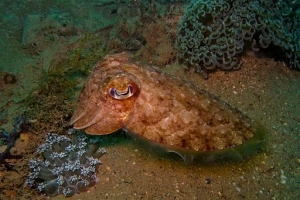My wife, Francesca sent me a link to this fascinating video about how certain cephalopods—squid, cuttlefish, and octopus, —employe camouflage. As a scuba diver and snorkeler, I knew a bit about this but admit was surprised at the extent of their abilities, particularly their use of pigments called chromatophores:
Most cephalopods possess chromatophores – that is, colored pigments – which they can use in a startling array of fashions. As well as providing camouflage with their background, some cephalopods bioluminesce, shining light downwards to disguise their shadows from any predators that may lurk below. The bioluminescence is produced by bacterial symbionts; the host cephalopod is able to detect the light produced by these organisms. Bioluminescence may also be used to entice prey, and some species use colorful displays to impress mates, startle predators, or even communicate with one another. It is not certain whether bioluminescence is actually of epithelial origin or if it is a bacterial production.
Here’s the amazing thing about the octopus in the video above: it’s colorblind. Yet as you can see in the clip, the animal can effectively camouflage by matching coloration. How does it do that? Even stranger—its not only capable of changing color via chromatophores—something other creatures like chameleons do—but it can even change the texture of its skin to more effectively blend in with its surroundings. I’m sure that, like me, you’re now considering all sorts of interesting applications for this remarkable natural technology, from clothing to interior design and to military camouflage.
Truly amazing …








